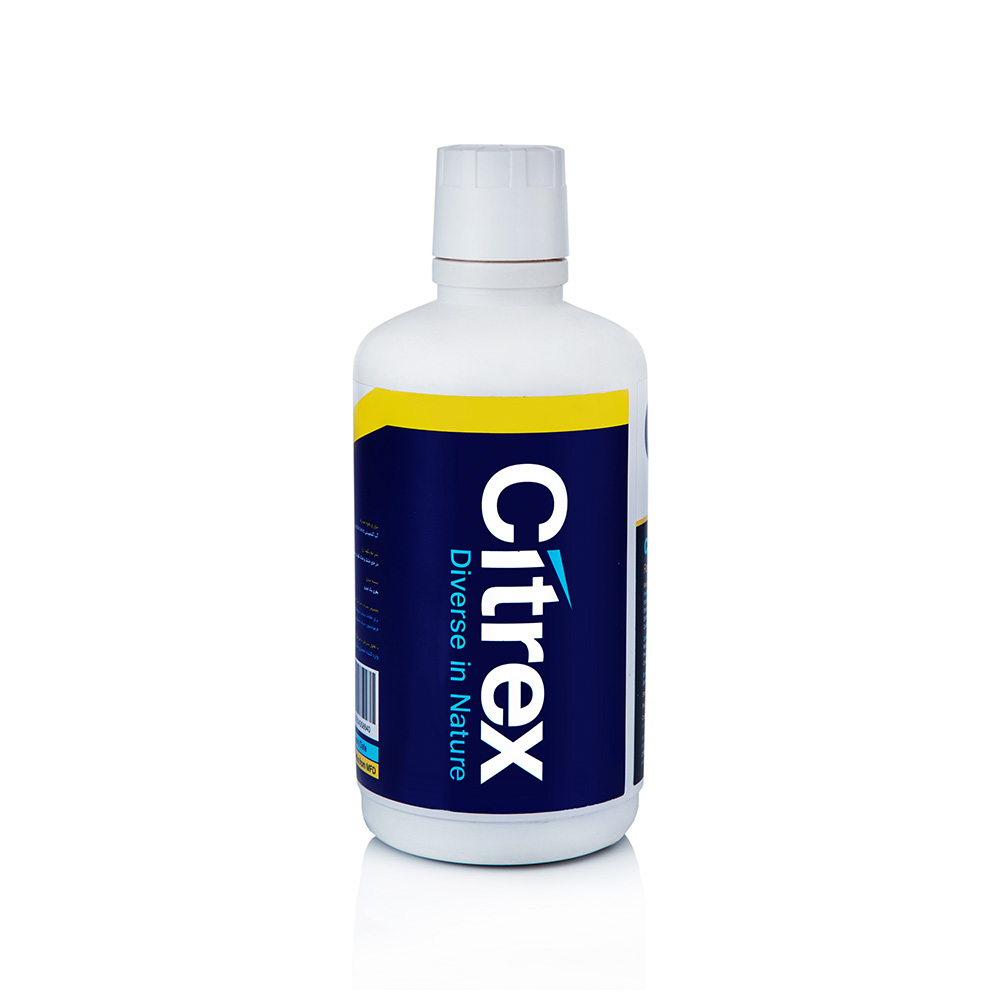Citrex
Product Description
Response of organic matter to poultry pathogens
Liquid Citrex is an ultrabiotic, antibacterial, antiviral and antifungal made from activated ascorbic acid (vitamin C) in combination with citric acid, lactic acid and glycerin.
Use in drinking water: Prevention and control of intestinal pathogenic bacteria such as Escherichia coli, Salmonella, Clostridium, etc.
Use as an aerosol (Nebulization): prevention and control of respiratory pathogens of poultry (such as mycoplasmosis, turkey rhinotracheitis, head syndrome), coryza and ….
Use as a general disinfectant: livestock, poultry farms, hatcheries, slaughterhouses and livestock and poultry products factories
Suitable for: Disinfectant
Brand: Citrex

Characteristics
Benefits of Citrex
1. Ecology / Consumption / Maintenance
- Free of animal compounds
- Registered as a disinfectant at a concentration of 1% by the US Environmental Protection Agency (EPA)
- Holds certificates from COCERT and OKO confirming the presence of organic compounds
- All components are classified by the FDA as General Recognized as Safe (GRAS)
- No period of abstinence when using drinking water
- Non-corrosion of farm supplies and equipment
- Absence of drug residue in meat and eggs produced while taking the drug
- Non-volatile and without the effect of burning and stinging on farm workers
- Non-carcinogenic – non-toxic
- With the ability to store more than 18 months in normal storage conditions
- Degradable in the environment
- Can be used simultaneously with chlorine in liquid solutions without losing the beneficial effects
- Durability of the effect for more than 48 hours as a disinfectant
- Easy to use in HACCP programs on farms, slaughterhouses and food processing plants (as a disinfectant)
2. General
- Effective on many antibiotic-resistant pathogen species
- Increase yields and reduce mortality in herds with low production history and efficiency
- Growth enhancer with control and prevention of diseases of the gastrointestinal tract (drinking) and respiratory diseases (aerosol)
- Reduction of environmental pollution and diffusion through the feces of animals with drinking salmonellosis)
- Affecting the offspring of mothers with Salmonella
- Prevention and control of intestinal colonization of salmonellosis
- Proof of its effectiveness by scientific studies in severe contrast with salmonellosis, necrotic enteritis, generalized basal cell carcinoma and ..
- Effective in the treatment and prevention of salmonellosis and general bacillus infections in the herd
- Non-interference with concomitant use of prebiotics, probiotics, antibiotics, sulfamides and organic acids in drinking water
- Without affecting the beneficial intestinal microflora and enhancing the effect of other competitive products such as probiotics
- Effective on gram-positive and gram-negative pathogenic bacteria
- Effective on mycoplasmas, viruses and respiratory fungi (via aerosol)
- Easy identification and detection of its main components by HPLC
- Effective against important pathogens that cause carcass contamination: Listeria, Campylobacter, Escherichia coli, Salmonella, etc. in the slaughterhouse
Response of organic matter to respiratory diseases
According to reports from modern poultry farmer, respiratory diseases are inevitable in all parts of the world. Factors such as high concentrations of ammonia, infectious coryza, avian rhinotracheitis, Newcastle disease and bronchitis, as well as Mycoplasma gali septicum (MG) and Mycoplasma synoviة (MS) are commonly associated with respiratory diseases.
The airways of chickens are covered by a mucous-musculoskeletal system that contains millions of delicate lashes that constantly expel mucus and secretions, dust particles, bacteria, fungi and viruses. This permanent evacuation reduces the presence of pathogens in the respiratory tract. If the bird loses this ability, invasive pathogens cause the chest and abdomen air sacs to swell, resulting in the presence of the most important secondary pathogen (E. coli), a respiratory disease. Ammonia gas is one of the main causes of damage to the respiratory cilia. Concentrations of more than 20 ppm per liter of this gas cause the movement of cilia in the trachea to disappear.
Sprays of antibiotics and other substances have been used for many years in humans and animals to treat respiratory diseases. Numerous scientific studies have shown that antibiotics such as oxytetracycline reduce the colonization of pathogenic bacteria in the trachea by spraying. For many years, many Asian and Latin American countries have been capturing disinfectants in the poultry industry to reduce the presence of bacteria in the upper respiratory tract.
How a spray disinfectant reduces microbial colonization in the upper respiratory tract
By spraying liquid Citrex, many pathogenic microbes located in the upper respiratory tract are removed. Therefore, the use of a disinfectant with a biocidal effect is important because it can kill bacteria, viruses and fungi. It should be noted that disinfectants that only prevent the growth and proliferation of microbes and do not destroy them (virostatics, bacteriostats, phonostatics), need time and the help of the immune system to eliminate the pathogenic mass.
The importance of when to start spraying
Spraying usually prevents the complication of the disease in flocks with a history of respiratory disease 48 to 24 hours after vaccination. If spraying is done when the birds show signs of sneezing and wheezing, limited treatment is given but it is not completely effective.
Supplies and equipment used
Sprayers: (Agricultural Knapsack / Backpack Sprayers)
Sprays that produce large particles (larger than 50 microns) are suitable because they do not reach the lower part of the respiratory tract and also to prevent damage to the airways.
Always turn off the vents when spraying and cover the room with a tent or curtain. Walk 10 to 15 minutes along the poultry house, depending on its size, and spray the entire herd. Spray the entire salon at least twice to achieve the desired result.
Response of organic matter to respiratory diseases
In ceiling mist systems:
Depending on the amount of water used in the system, spray through the nozzles for 5-10 minutes. If possible, turn off the ventilation fans.
Repeat this process to better cover the herd.
Spray Citrex on MS / MG-positive herds to aid treatment:
Spray Citrex for 3-5 days and 2 times a day. In addition, anti-mycoplasma drugs such as tylosin, enrofloxacin, thiamulin, etc.
Preferably consume in drinking water or in the diet in the first three days of chickens’ life.
Citrex for 3-5 days and 2 times a day, when again mycoplasma drugs 2 days after vaccination. Spray respiratory viruses (usually day 12-14) Spray.
Citrex can also be taken with anti-mycoplasma drugs and drinking water.
Prevention of complications after vaccination and treatment of birds with respiratory symptoms:
Apply according to the above instructions and spray only 12 hours after vaccination for at least 5 consecutive days twice a day.
In herds showing respiratory symptoms, it should be consumed for 4-5 days and 2 times a day. The duration of treatment can be increased if necessary. The best results are obtained when Cyrex is consumed simultaneously with drinking water.
Citrex consumption rate (by spray):
1000 ppm equivalent to 100 cc of liquid Citrex per 100 liters of water.
Warning: Citrex should never be sprayed during vaccination. Do not spray Cytrex 24 hours before and 12 hours after vaccination.
Response of organic matter to respiratory diseases
Efficacy of Liquid Citrex in Salmonella Colonization in Broilers:
Salmonella infections in birds and humans are one of the most important diseases affecting the poultry industry worldwide. In most developed countries, Salmonella plurum and gallinarum species have been eradicated, but others classified as paratyphoid (Salmonella enteritidis Salmonella typhimurium, etc.) are still a major public health problem.
Salmonella heidelberg is one of 12 species of paratyphoid groups that cause disease in humans without harming birds. It is noteworthy that Salmonella is the second or third most common cause of Salmonella in humans in countries such as the United States and Canada.
Scientific and practical studies have shown that after 9 days of treatment with other individuals at a rate of 300 ppm, a significant reduction in the colonization of Salmonella heidelberg (S. h) in the environment, stratum corneum and intestines of birds compared to untreated flocks. Has been obtained.
Efficacy of Citerex against necrotic intestinal inflammation (necrotic enteritis)
Studies have shown that consumption of Citerex at a rate of 200 ppm in drinking water can be effective in the treatment of necrotic enteritis and cause a significant increase in weight gain of chickens compared to untreated herds.
Also, the mortality rate has decreased from 5.12% to 0.3%.
| Concentration of CITREX in ppm | Volume of CITREX 100% in 100 liters (27.3 gallons) of water |
| 50 | 5.0 ml |
| 100 | 10.0 ml |
| 200 | 20.0 ml |
| 300 | 30.0 ml |
| 400 | 40.0 ml |
| 500 | 50.0 ml |
| 600 | 60.0 ml |
| 800 | 80.0 ml |
| 1000 | 100.0 ml |
Composition
| . | . |
|---|---|
Dosage and Instructions
Sprayers: (Agricultural Knapsack / Backpack Sprayers)
Sprays that produce large particles (larger than 50 microns) are suitable because they do not reach the lower part of the respiratory tract and also to prevent damage to the airways.
Always turn off the vents when spraying and cover the room with a tent or curtain. Walk 10 to 15 minutes along the poultry house, depending on its size, and spray the entire herd. Spray the entire salon at least twice to achieve the desired result.
Studies have shown that consumption of Citerex at a rate of 200 ppm in drinking water can be effective in the treatment of necrotic enteritis and cause a significant increase in weight gain of chickens compared to untreated herds.
Also, the mortality rate has decreased from 5.12% to 0.3%.

Cow

Calf

Horse

Foal

sheep

Hen

Chicken

Cat

Dog

